
Chapter 2: Adapting the Corporate Innovation Playbook
Corporate innovation is evolving fast in 2025. 70% of companies are shifting from strategy to action - prioritizing speed, ROI, and core business impact. The key? Adapting through Venture Clienting. This model helps corporates solve real problems with startup solutions - quickly, efficiently, and at scale. In this post, we unpack four key signals driving this change and why decentralized startup collaboration is becoming the gold standard.
This post is Chapter 2 of our upcoming Impact Study Volume II, diving into the signals and systems defining the next wave of corporate innovation.

In Chapter 1 of this series, we unpacked the defining paradox of corporate innovation in 2025: budgets are tightening just as the pressure to reinvent is hitting an all-time high.
If you missed it, we explored why innovation (as a corporate function) is under fire, how economic uncertainty is reshaping boardroom behavior, and why CEOs are prioritizing reinvention and cost-cutting at the same time.
Today, we’re picking up right where we left off, with the final word of that chapter: adaptation.
Because something is shifting in corporate innovation. Quietly, but unmistakably.
Research from BCG confirms what we’re hearing from innovation leaders every day:
- The majority of corporations (70% to be exact) are now actively adapting by changing how they run innovation. They’re upgrading their operating models, moving toward initiatives that prioritize speed, agility, and scale.
- The other 30%? They’re stuck in strategy mode, returning to their PowerPoint decks instead of reshaping their processes.
In other words: adaptation through action, not abstraction.
Let’s unpack four key signals that show how the best corporate innovators are adapting in 2025, and what others can learn from them.
1. Make innovation serve the core business!
Once the playground for speculative bets and long-term moonshots, corporate innovation is now heading much closer to the parent company’s core operations.
- Whether through Venture Partnering, Venture Building, or CVC investments, innovation vehicles that once focused on Horizon 2 and 3 have pivoted in 2025.
- Today, they’re being repurposed to solve real problems in real time.
Venture Clienting best exemplifies this shift. Originally part of the broader Venture Partnering toolbox, it has broken out as its own category, precisely because it zeroes in on immediate, high-priority business challenges. It’s the most core-focused innovation discipline of them all.
At GlassDollar, we see this shift towards near-term core impact across dozens of corporate teams. A new idea (or interesting startup) that used to be pitched as “future potential” is now assessed like any other business function:
- Does it improve supply chains?
- Reduce waste?
- Drive automation?
- Deliver ROI in the next 12 months?
Global Corporate Venturing research backs this up. CVC investment logic, for example, has flipped.
- 40% of all CVC deals in 2025 are now driven by the goal of supporting existing business activities.
- That makes it the #1 investment rationale for corporate VC arms, overtaking Horizon 2 and Horizon 3 motives for the first time.
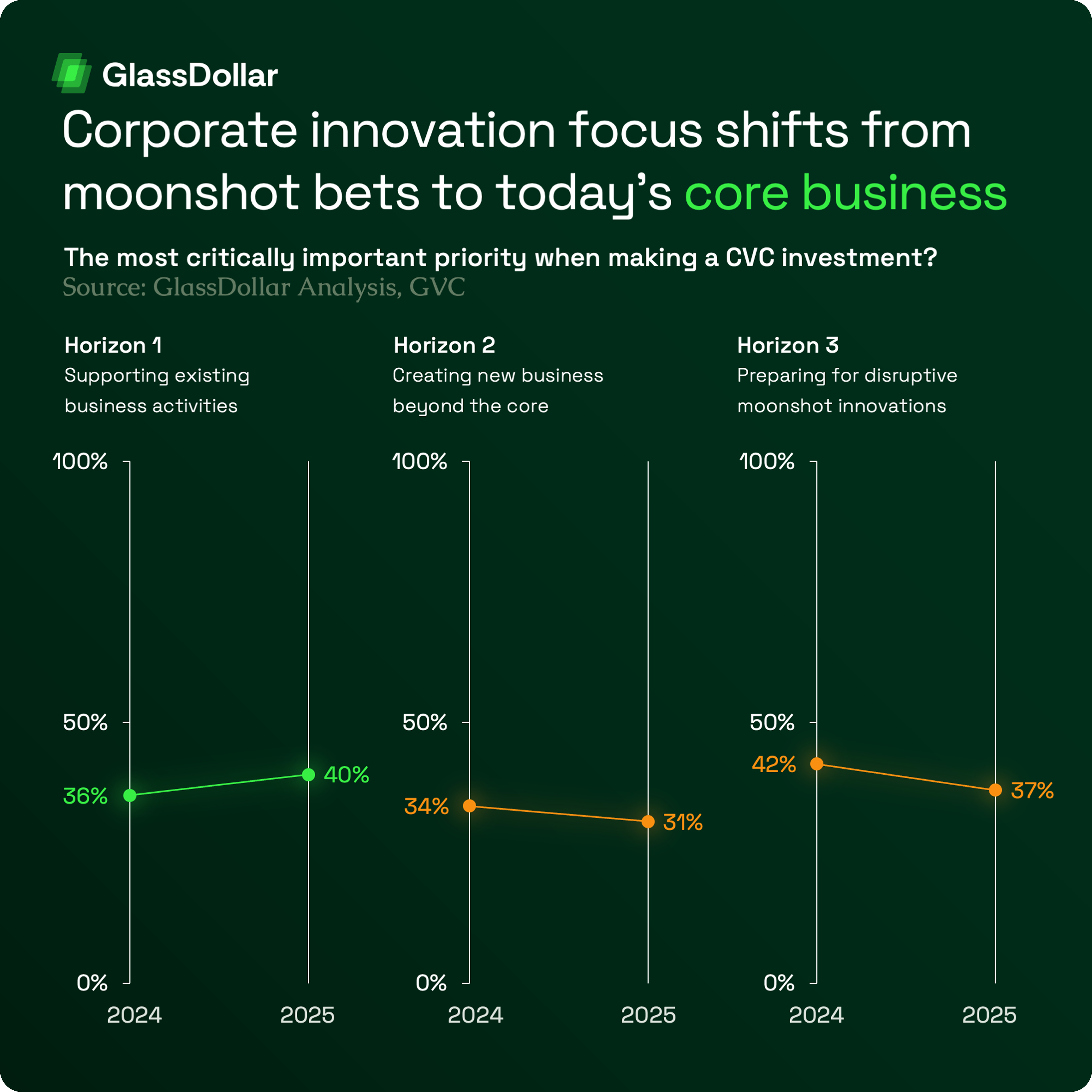
This core-first logic isn’t limited to CVC. We’re seeing the same shift across Venture Building and Venture Partnering, both of which are increasingly gravitating toward the operational focus that Venture Clienting has already made its trademark.
Alongside this shift comes another important change: the language of innovation.
- Startup-speak is out.
- Finance-speak is in.
Innovation teams that used to pitch visions and disruption are now pitching balance sheets. Because in 2025, winning leadership buy-in means tying every initiative, every PoC, every pilot, every partnership, back to hard KPIs like cost savings, revenue upside, and ROI in 6 to 18 months.
No more fluff. No more theater. Just business.
And this new business-minded approach is creating ripple effects in how innovation teams are staffed and structured.
2. Use external solutions to solve internal problems!
As corporate innovation grows up (or as our CEO Fabian Dudek likes to say, it graduates), it’s not just the approach that’s evolving, but also the people behind it.
At GlassDollar, we’re seeing firsthand how innovation teams are becoming sharper and more business-savvy in how they identify the right solutions.
- They’re no longer chasing shiny stories or surface-level PR wins.
- They’re hunting for impact.
The people running these teams today are more educated, more grounded, and, crucially, more trusted by their leadership and business units to pick winners that can deliver real results.
And that’s led to a noticeable shift in mindset:
- External solutions, especially those coming from startups, are finally getting the recognition they deserve.
- Whereas startup collaborations used to be treated as PR plays or long-shot experiments, they’re now increasingly seen as serious answers to core business needs.
This shift is not just anecdotal; it’s backed by data.
In corporate innovation research by Capgemini Invent, external startups were cited as the single most effective and viable source of innovation, by far outpacing internal R&D, suppliers, university labs, and other traditional sources.
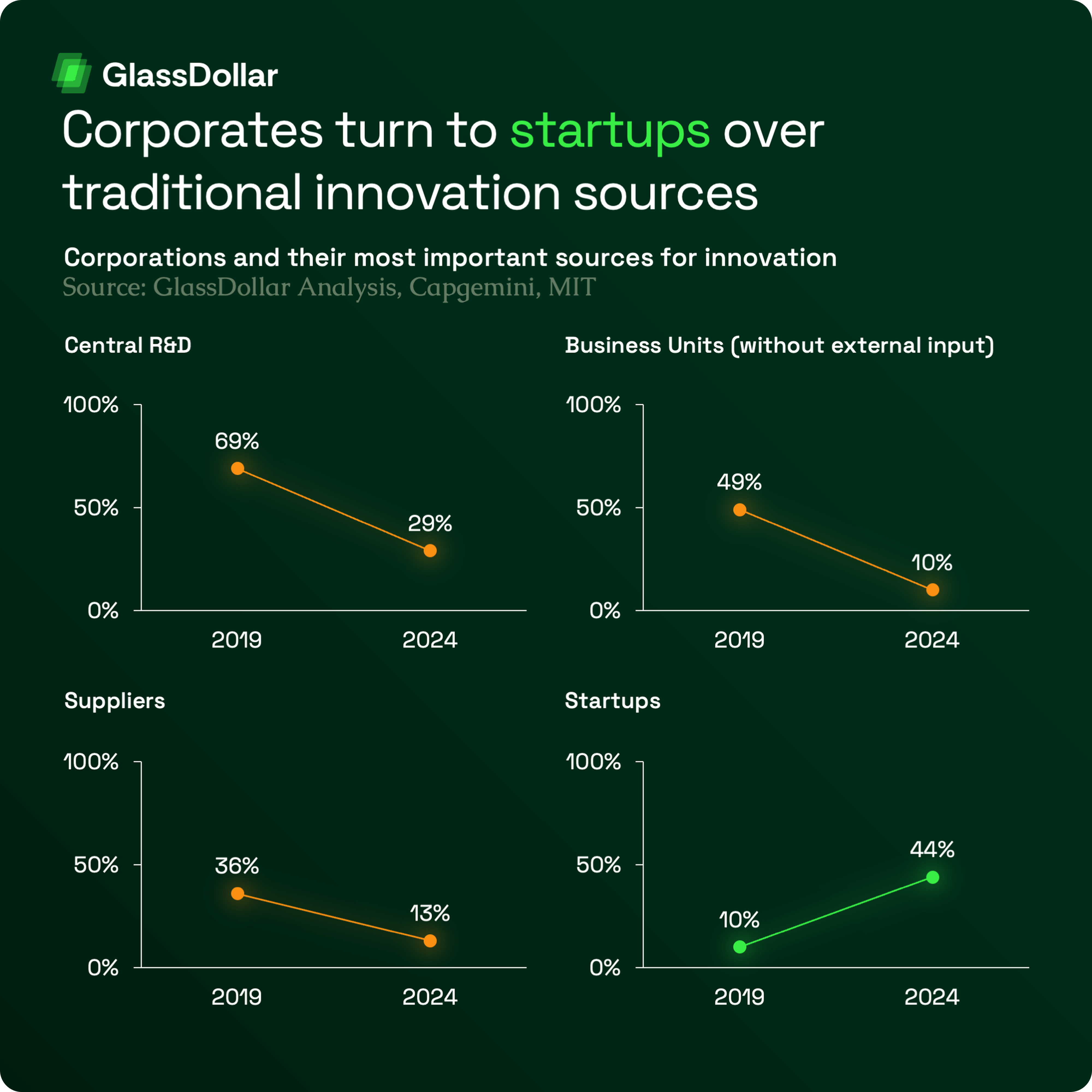
What’s changed?
Put simply, corporations have stopped pretending they can solve every problem in-house.
The maturity of today’s innovation mindset means leaders are more candid about their capability gaps and more proactive about closing them through targeted startup collaborations. On top, the old narrative painted startups as disruptors, potential threats aiming to replace or outpace incumbent companies. That mindset is fading.
Today, the leading corporates increasingly see startups as enablers. Partners. Extensions of their own capabilities.
Accordingly, the spotlight has shifted away from big-vision “industry reinventors.”
- Instead, it’s the practical, proven startups that are gaining traction, those offering plug-and-play solutions to real operational pain points.
- Solutions that are easy to integrate into existing systems and deliver value from day one.
Corporates realize they can no longer afford to sit on the sidelines and treat these solutions as experimental side projects.
The real risk is not being replaced by a startup; it’s being overtaken by a competitor who’s already working with the startup solution.
- Just like with AI, the threat isn’t the technology itself.
- It’s failing to adopt and apply it faster than others do.
That’s why the best corporate innovators are now moving fast: testing, validating, and scaling startup solutions in a systematic, high-priority way.
Which brings us to our next signal.
3. Prioritize Venture Clienting as your default innovation tool!
The growing demand for startup-driven solutions is reshaping how companies innovate.
Nowhere is this shift more visible than in the rise of Venture Clienting.
Once seen as a niche or even half-hearted approach, Venture Clienting has quietly become a centerpiece of corporate innovation strategy.
Why? Because it fits the economic climate of today.
We’re not saying it’s replacing Corporate Venture Capital or Venture Building. As our CEO Fabian Dudek 🟩 put it in this post, the belief that these models compete is one of corporate innovation’s biggest misconceptions.
They’re not rivals, they're a toolkit.
And the best companies don’t use every tool at once. They reach for the one that gets the job done.
Right now, Venture Clienting gets the job done.
- It’s fast.
- It’s pragmatic.
- It’s resource-efficient.
- And, when executed well, it delivers.
Done right, it turns startup collaboration into a repeatable business process, one that unlocks small, fast wins and builds innovation momentum exactly where it matters: the core business.
This pivot is clearly visible in the data:
- The number of active CVC units globally has dropped more than 15% since 2021 (GVC, 2025).
- CEO prioritization of Venture Building is down nearly 20% in the same period, according to McKinsey.
- Meanwhile, interest in Venture Clienting has tripled since 2021.
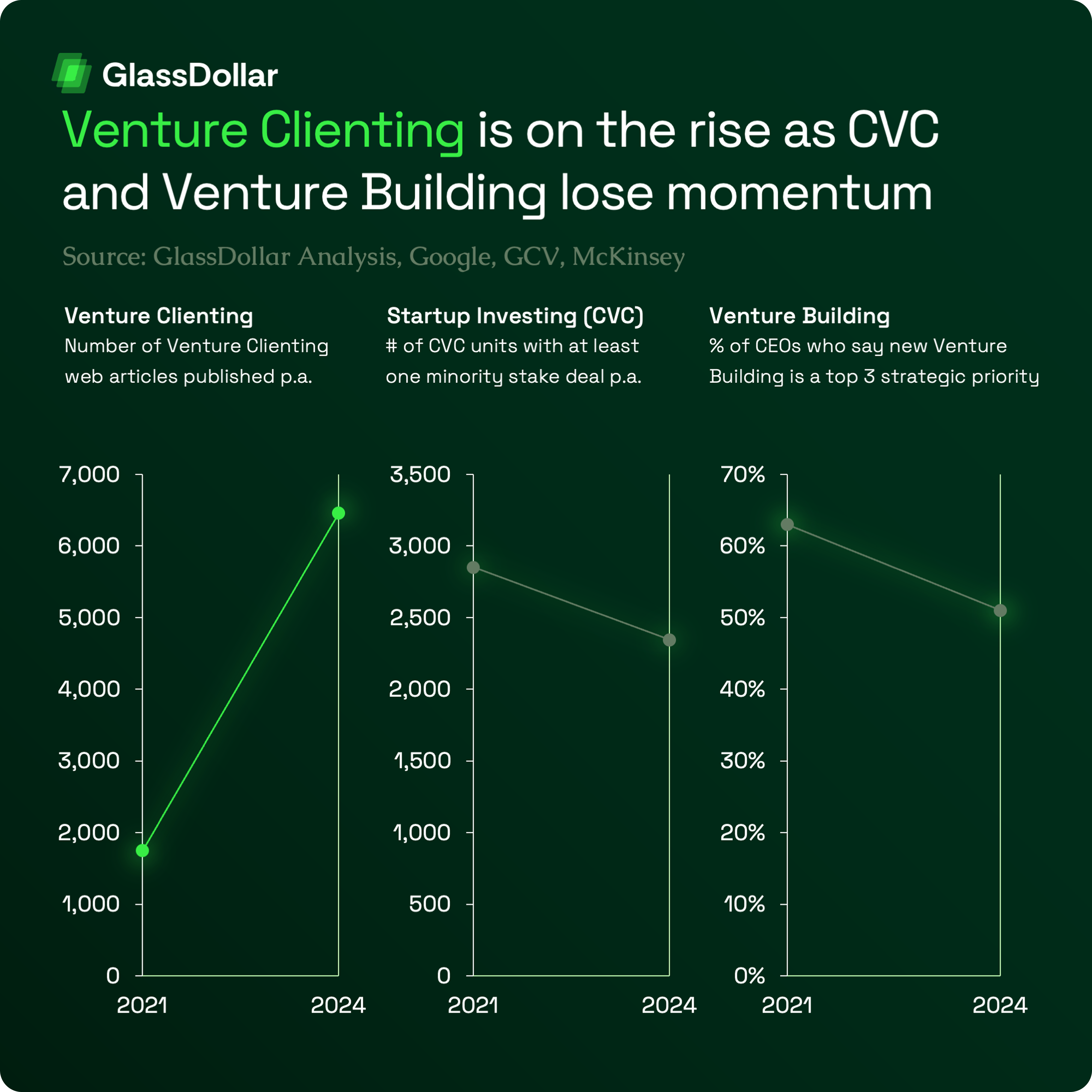
And it’s not just interest. The Venture Clienting movement has been institutionalized.
Today, 97% of leading corporations have implemented some form of Venture Clienting, making it the most widely adopted innovation model in the corporate playbook.
Why?
Because it’s essentially the professionalized discipline of systematically leveraging startup solutions.
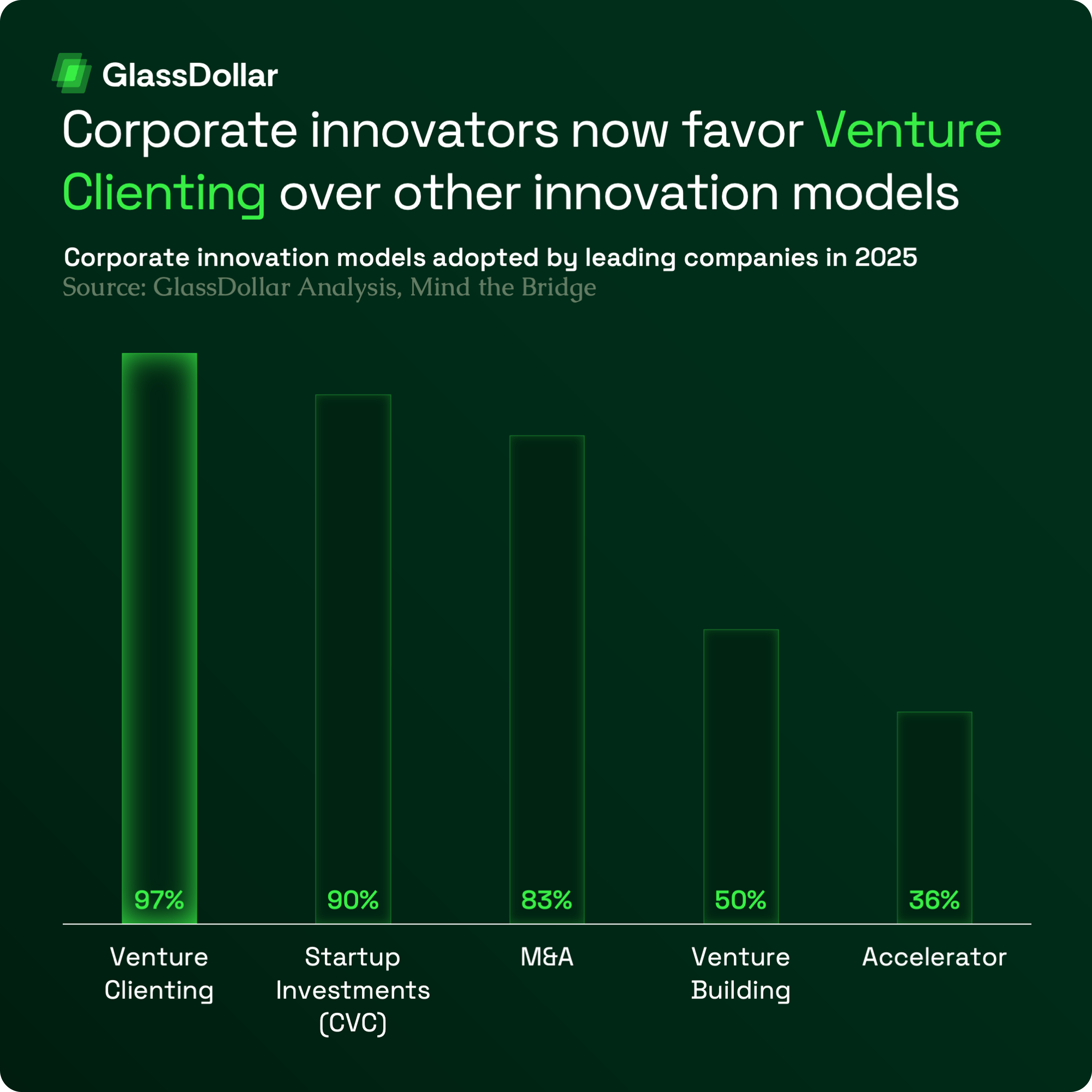
But there's another reason this approach is booming: it multiplies your innovation capital, without draining your own budget.
- Corporations across OECD countries spent nearly $200 billion USD on internal R&D in 2024.
- But the pool of capital raised by startups that corporations could partner with? Over $300 billion USD in additional innovation dollars.
That’s more than 1.5 times the innovation firepower, funded by VCs, not balance sheets.
We conclude: In a world of tighter budgets and higher stakes, Venture Clienting is a strategic upgrade.
And it’s laying the foundation for a new kind of innovation playbook.
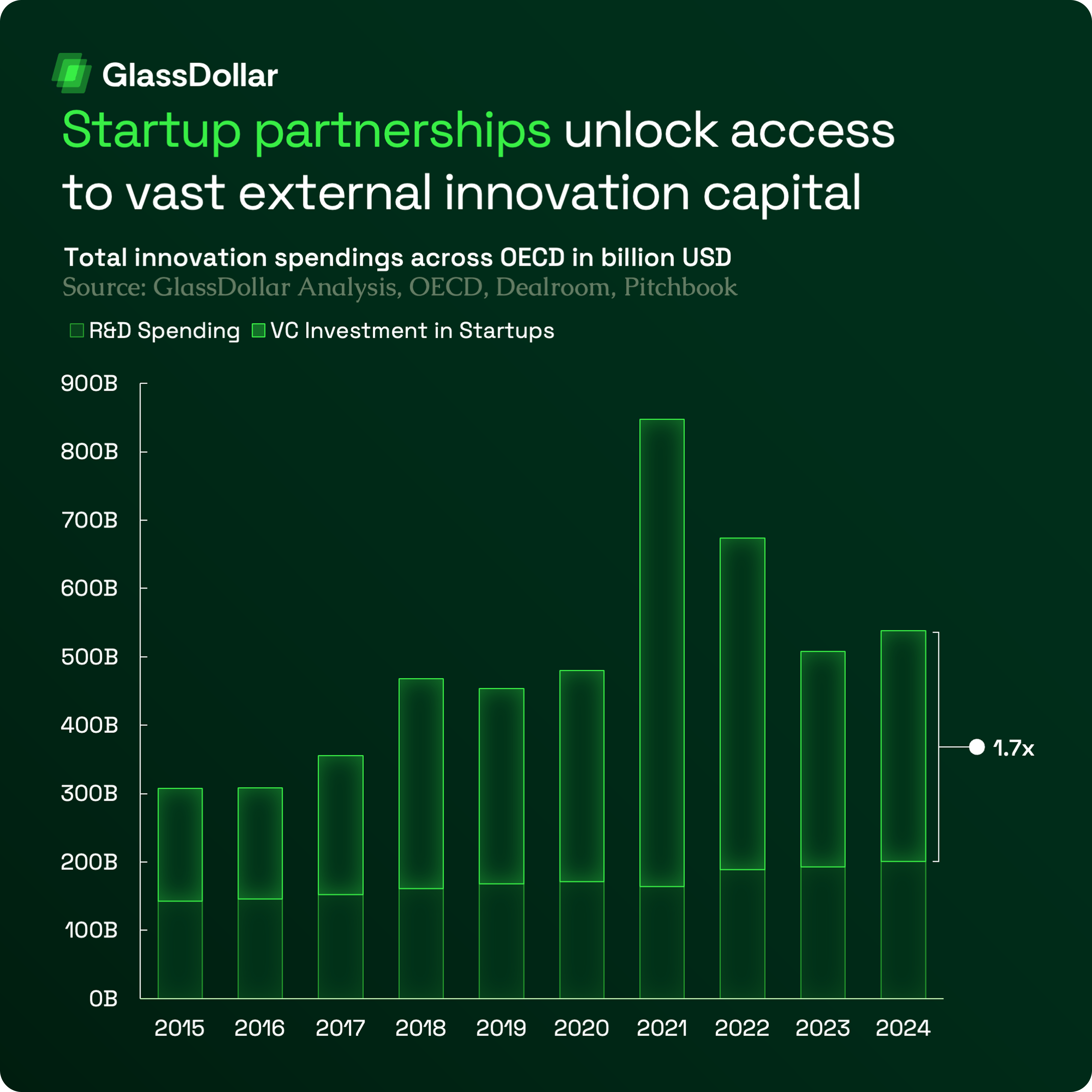
4. Scale Venture Clienting by decentralizing it!
When we speak with leading innovation teams in our GlassDollar network, one thing becomes clear: Venture Clienting is not only gaining relevance, it's also evolving.
Two major shifts define this evolution in 2025.
First, scale.
- In many organizations, Venture Clienting began as accidental innovation. Business units occasionally connected with startups, often through informal introductions, but there was no structured follow-up, no PoC tracking, and no ownership. At GlassDollar, we call this Venture Clienting by coincidence.
- The next level of maturity saw companies centralize these efforts. Innovation hubs or labs took the lead, initiating and managing a handful of startup PoCs per year. These teams introduced tracking, standardized processes, and started to build a repeatable model.
- But the real inflection point comes further up the curve. And that’s what we’re now seeing in a growing number of leading companies: Venture Clienting at scale.
The most advanced organizations don’t run five pilots a year; they run hundreds. Sometimes thousands.
What used to be a one-off innovation showcase has become an industrialized collaboration process. Venture Clienting is now a core operational tool, embedded into day-to-day execution.
So, how are these companies scaling so dramatically?
That’s where shift number two comes in: ownership.
Central innovation units were instrumental in professionalizing Venture Clienting, and they continue to play a vital role. But their responsibilities have evolved.
In many of the most successful companies we see today, these central teams now act as enablers of decentralization: building the infrastructure, standardizing tracking systems, and equipping other teams across the organization with the tools to scale.
- What’s changed is that these units are no longer the sole owners of startup collaboration.
- Instead, Venture Clienting is increasingly embedded across the business.
- Business units, procurement teams, and operations leads – those closest to the problems – are now empowered to drive startup engagements themselves.
And it’s this very shift that unlocks true scale.
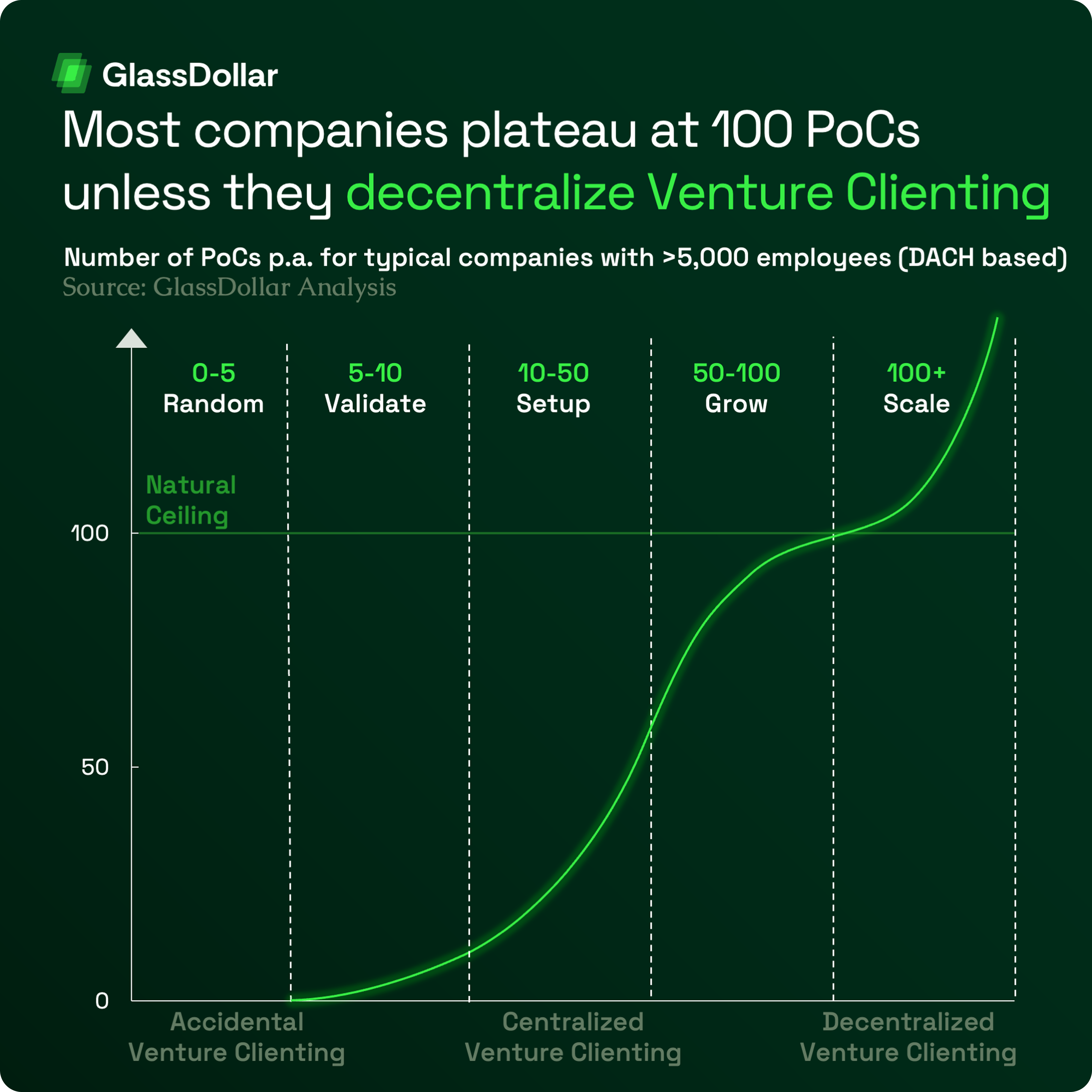
Real-world leaders prove the point.
Our GlassDollar vclOS database confirms that the most mature Venture Clienting organizations have embraced decentralization to drive scale.
Take Siemens and Mercedes-Benz AG, for example:
- Siemens has built 723 startup partnerships over the years.
- Mercedes-Benz Group, 438.
And the majority of these collaborations are no longer exclusively initiated by central innovation hubs or Venture Clienting units.
Instead, they often originate directly from business units, frequently in close alignment with central innovation teams.
So, after playing a foundational role – laying the groundwork, advocating for dedicated processes, and professionalizing the discipline – many central Venture Clienting
teams now empower the broader organization to lead engagements autonomously and at scale.
And while Siemens and Mercedes-Benz are clearly ahead of the curve, they’re still on the journey. With organizations spanning hundreds of thousands of employees, building the infrastructure to track, manage, and scale PoCs across business units remains a work in progress.
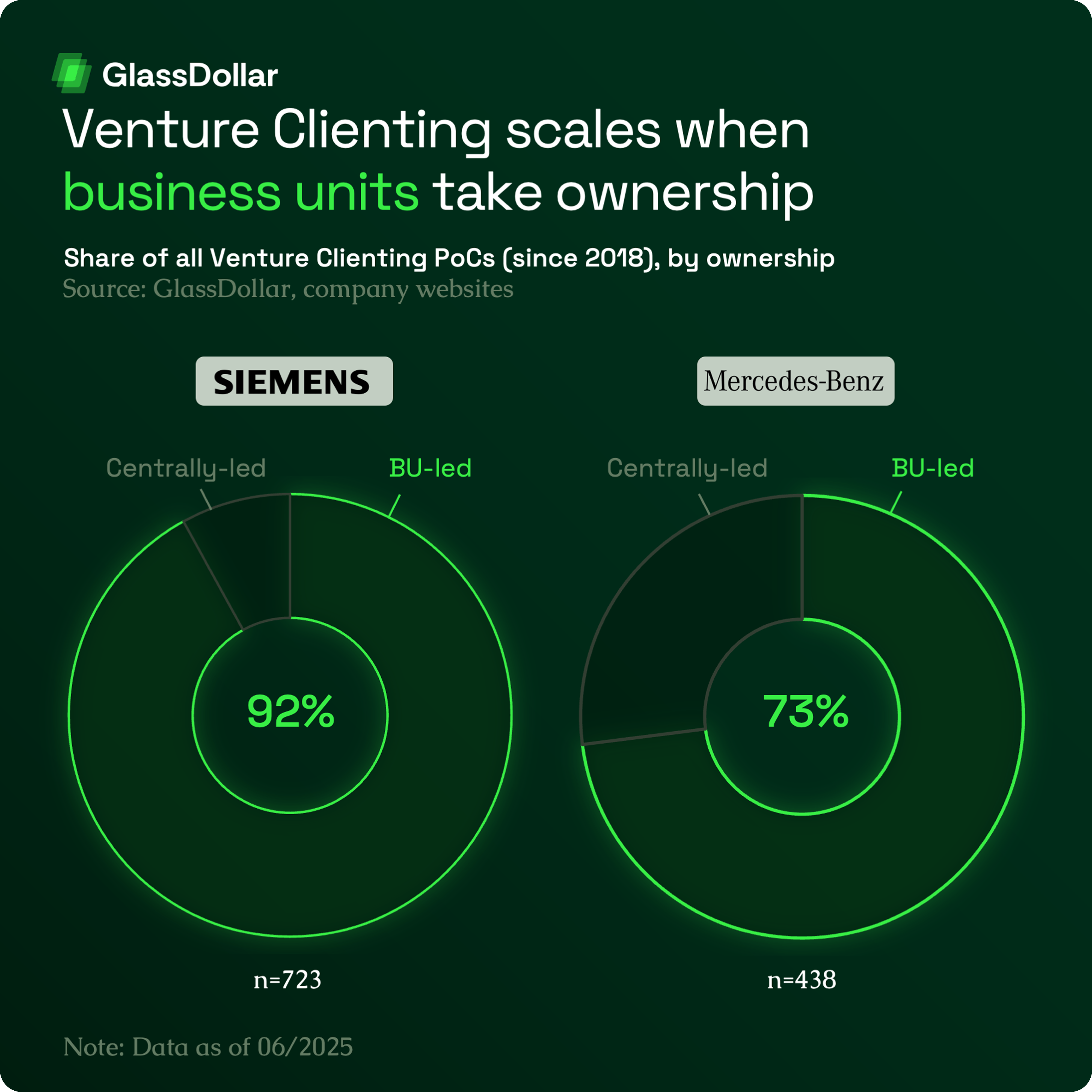
Are you part of Siemens, Mercedes-Benz Group, or another corporate innovator and want to see the full list of all startup partners behind the numbers?
👉 Request access here: hello@glassdollar.com
At this decentralized scale, Venture Clienting stops being an innovation tool.
It becomes a strategic muscle, a systematic way to inject external solutions into every corner of the business, across functions, regions, and P&Ls.
And the evolution doesn’t stop there.
The most mature organizations don’t even frame it as “startup partnerships” anymore.
They’ve expanded the scope. For them, Venture Clienting has become a solution-matching system. Label-agnostic and outcome-driven.
- Startup, scale-up, solo founder, or mid-sized vendor? It doesn’t matter.
- What matters is speed, fit, business value, and getting access to the best solutions as early as possible.
Because in 2025, the best solution is simply the one that works.
What’s next?
In this edition, we decoded four signals that define how corporate innovation is changing in 2025.
But theory only gets you so far.
Next month, we’re shifting gears from signals to spotlights.
- We’ll unpack the real-world playbooks of the companies leading this shift – those not just talking about innovation, but operationalizing it every single day.
- Think: 100+ PoCs a year. Fully decentralized startup collaboration. Seamless solution matching at scale.
Who’s doing it best? Let us show you. Stay tuned.


.png)


.png)